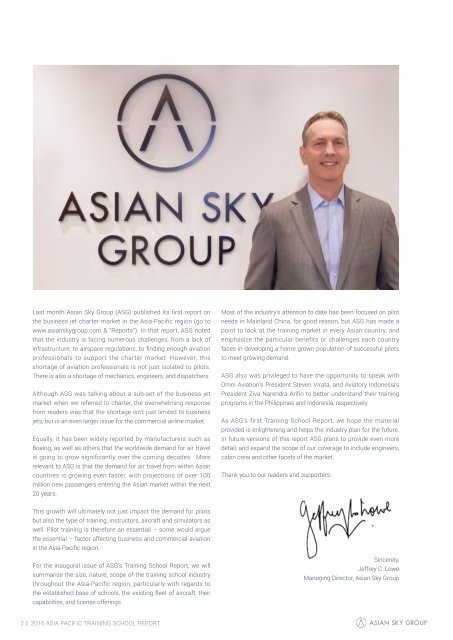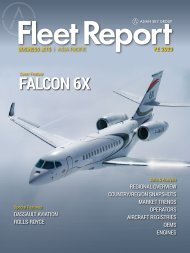Create successful ePaper yourself
Turn your PDF publications into a flip-book with our unique Google optimized e-Paper software.
Last month Asian Sky Group (ASG) published its first report on<br />
the business jet charter market in the Asia-Pacific region (go to<br />
www.asianskygroup.com & “<strong>Report</strong>s”). In that report, ASG noted<br />
that the industry is facing numerous challenges, from a lack of<br />
infrastructure, to airspace regulations, to finding enough aviation<br />
professionals to support the charter market. However, this<br />
shortage of aviation professionals is not just isolated to pilots.<br />
There is also a shortage of mechanics, engineers, and dispatchers.<br />
Although ASG was talking about a sub-set of the business jet<br />
market when we referred to charter, the overwhelming response<br />
from readers was that the shortage isn’t just limited to business<br />
jets, but is an even larger issue for the commercial airline market.<br />
Equally, it has been widely reported by manufacturers such as<br />
Boeing, as well as others that the worldwide demand for air travel<br />
is going to grow significantly over the coming decades. More<br />
relevant to ASG is that the demand for air travel from within Asian<br />
countries is growing even faster, with projections of over 100<br />
million new passengers entering the Asian market within the next<br />
20 years.<br />
Most of the industry’s attention to date has been focused on pilot<br />
needs in Mainland China, for good reason, but ASG has made a<br />
point to look at the training market in every Asian country, and<br />
emphasize the particular benefits or challenges each country<br />
faces in developing a home grown population of successful pilots<br />
to meet growing demand.<br />
ASG also was privileged to have the opportunity to speak with<br />
Omni Aviation’s President Steven Virata, and Aviatory Indonesia’s<br />
President Ziva Narendra Arifin to better understand their training<br />
programs in the Philippines and Indonesia, respectively.<br />
As ASG’s first <strong>Training</strong> School <strong>Report</strong>, we hope the material<br />
provided is enlightening and helps the industry plan for the future.<br />
In future versions of this report ASG plans to provide even more<br />
detail, and expand the scope of our coverage to include engineers,<br />
cabin crew and other facets of the market.<br />
Thank you to our readers and supporters.<br />
This growth will ultimately not just impact the demand for pilots<br />
but also the type of training, instructors, aircraft and simulators as<br />
well. Pilot training is therefore an essential – some would argue<br />
the essential – factor affecting business and commercial aviation<br />
in the Asia-Pacific region.<br />
For the inaugural issue of ASG’s <strong>Training</strong> School <strong>Report</strong>, we will<br />
summarize the size, nature, scope of the training school industry<br />
throughout the Asia-Pacific region, particularly with regards to<br />
the established base of schools, the existing fleet of aircraft, their<br />
capabilities, and license offerings.<br />
Sincerely,<br />
Jeffrey C. Lowe<br />
Managing Director, Asian Sky Group<br />
2 | 2016 ASIA PACIFIC TRAINING SCHOOL REPORT

















